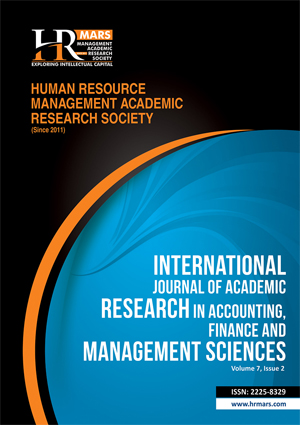
ISSN: 2225-8329
Open access
The government used a tool called Key Performance Indicators (KPIs) to measure how well employees did at work for a few years. In the present era, the majority of successful organizations have a performance evaluation system in place. The aims of this paper is to examine the benefits of having Key Performance Indicators (KPI) in the public sector that are being implemented in the Malaysian public sector, as a result of Government Circular 20. With the advancement of public sector reforms, the government has developed its own set of key performance indicators (KPIs) for evaluating agency performance. According to the findings, KPIs have been effective in measuring both organizational and individual performance. This article concludes that KPI implementation enables the public sector in optimizing the potential to enhance the public officials’ performance in providing efficient service.
Abu Bakar, N. B., & Ismail, S. (2011). Financial management accountability index (FMAI) in Malaysian public sector: A way forward. International Review of Administrative Sciences, 77(1), 159-190
Aziz, A. F., & Khalid, N. A. (2010). The perception of civil service on the introduction of Key Performance Indicators (KPI), in: ICOPS 2010: International Conference on Public Polices & Social Sciences: E-Proceedings, 26 to 27 May 2010
Jusoh, R., Hartono, R., & Abu Hassan, H. (2012). Performance measurement in Malaysian public sectors: An exploratory study. Journal of Global Strategic Management, 1(6), 87-120
Jahangirian, M., Taylor, S. J. E., Young, T., & Robinson, S. (2017). Key Performance Indicators for successful simulation projects. Journal of the Operational Research Society, 68(7), 747-765
Lindberg, C. F., Tan, S., Yan, J., & Starfelt. (2015). Key Performance Indicators improve industrial performance. Energy Procedia, 75, 1785-1790
Mallow, M. S. (2016). Occupational stress in Malaysia: Causes, effects and possible solutions. Socioint16: 3rd International Conference on Social Sciences and Humanities
Mallow, M. S. (2017). Implementation of Key Performance Indicators and the issue of occupational stress in Malaysia, in: 4th International Conference on Education and Social Sciences (Intcess 2017)
Setiawan, I., & Purba, H. H. (2020). A systematic literature review of Key Performance Indicators (KPIs) implementation. Journal of Industrial Engineering & Management Research, 1(3), 200-208
Nadiah, B. A., Amizawati, M. A., & Farahhani, S. I. (2019). Key Performance Indicators tugas, ganjaran dan prestasi kerja guru sekolah kerajaan. Jurnal Kepimpinan Pendidikan, 6(4), 38-60
Malaysia. (2017). Chapter 12: Enhancing accountability with ministerial KPIs. In: GTP Roadmap, Putrajaya: Prime Minister OfficeSiddique, N.A. (2010). Managing for results: Lessons from public management reform in Malaysia. International Journal of Public Sector Management, 23(1), 38-53
Xavier, J. A. (2009). Establishing Key Performance Indicators for the senior echelons of the public service. Journal Excellence, 1(1), 18-43
Zaherawati, Z., Mahazril, A. Y., Zuraini, Y., Nazni., Hilmie, M. Z. M. S., & Zuriawati, Z. (2011). Key performance indicators (KPIs) in the public sector: A study in Malaysia. Asian Social Sciences, 7(7), 102-107
In-Text Citation: (Abdullah et al., 2022)
To Cite this Article: Abdullah, A. S. B., Zulkifli, N. F. B., Zamri, N. F. B., Harun, N. W. B., & Abidin, N. Z. Z. (2022). The Benefits of Having Key Performance Indicators (KPI) in Public Sector. International Journal of Academic Research in Accounting Finance and Management Sciences, 12(3), 719–726.
Copyright: © 2022 The Author(s)
Published by Human Resource Management Academic Research Society (www.hrmars.com)
This article is published under the Creative Commons Attribution (CC BY 4.0) license. Anyone may reproduce, distribute, translate and create derivative works of this article (for both commercial and non-commercial purposes), subject to full attribution to the original publication and authors. The full terms of this license may be seen at: http://creativecommons.org/licences/by/4.0/legalcode